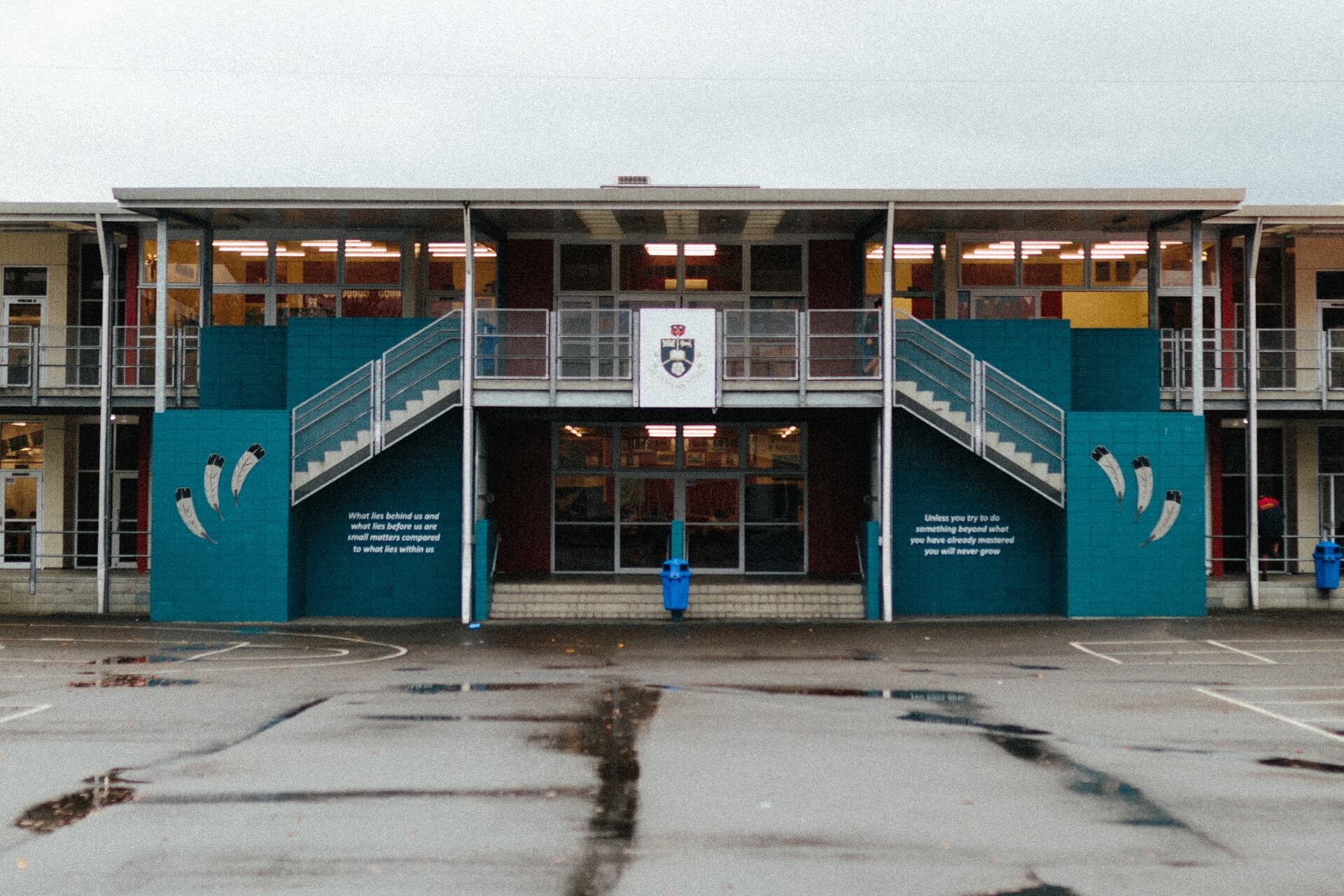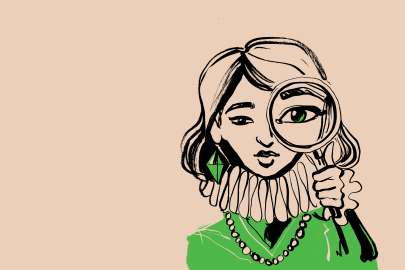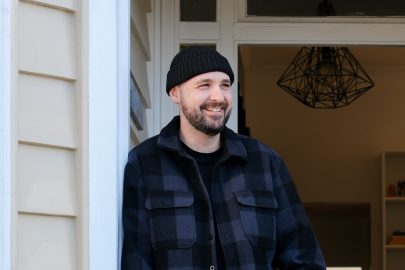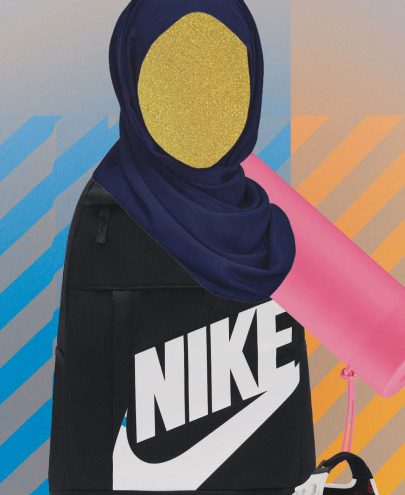Jul 24, 2022 Schools
Rie Morris speaks with urgency at all times. Her work is essential, and she knows it. Her students are never far away — the nearby walls cannot contain their rhythmic footsteps and waiata. You can tell she is itching to get back to her mahi. She has spent the last five years at Rotorua Boys’ High School and says she will spend the rest of her teaching life there. “This is my second school and this will be my last school. I have no desire to leave this place. I love it so much.”
Morris (Te Arawa, Tūhoe, Ngāi Te Rangi, Tūwharetoa and Ngāpuhi) is a tumuaki tuarua, a deputy principal, at the school and she is a rather special one at that. She is the first wahine to hold a tumuaki tuarua role in the school’s history. It’s not hard to see why she loves this place. Despite the saturnine weather today, the Rotorua Boys’ High School campus is alive. If you can’t hear kapa haka somewhere, it’s only because there’s a Pasifika drum beat vibrating along the wooden floors or a rock band re- hearsing in an echoing hall. The soundscape of the school is almost too good to be true.
According to Morris, “every day is a happy day” at Rotorua Boys’ High School. For a school that is going on 113 years, that is a lot of happy days, and a big call to make. But this is a high school, after all. Surely, it’s not all good. Is it?
Walking across the campus, it’s easy to forget this is a publicly funded school, established by His Majesty’s Government in 1927. The administration building, built in a quasi-colonial style, is a testament to its past. But across the school recent design choices subvert that history. Whakairo welcome you into the administration building, kōwhaiwhai guide you through the halls, and taonga meet you at each of your destinations through the day. It makes sense, then, that the school community rarely burdens itself with the cumbersome title of Rotorua Boys’ High School. Raukura is much more appropriate. The word ‘raukura’ directly translate to plume, a prized decoration of feathers, usually of huia or albatross. Raukura are often markers of leadership status.
The name is fitting because the staff and students at Raukura are leaders in education in Aotearoa. Their tumuaki, or principal, is guiding the school through changes much more significant than a new name. Chris Grinter has been steering the waka at Raukura since 1991. Grinter made the move after serving an apprenticeship as deputy principal at Wesley College in South Auckland. Before that, he’d spent time teaching in London and Ngāruawāhia, his hometown. In his time at Wesley, Grinter was famous for recruiting the great Jonah Lomu, then a league-mad third former, to rugby union and the First XV. In his autobiography Lomu credits Grinter with changing his life, recounting one of his most memorable high-school rugby moments — scoring five tries against the Rotorua Boys’ High First XV.
Mr Grinter is only the fourth person to hold the position in the years since the girls’ school broke away in 1960 to accommodate Rotorua’s growing population. At Rotorua Boys’ High, tumuaki stay for a long time — the low turnover rate is testament to the strong culture of the school. “My years here are decorated with these beautiful moments of real success, and they’re across the board,” he says.
In 2019, the school won the Prime Minister’s Excellence in Leading Award as well as the Prime Minister’s Supreme Education Excellence Award. In 2018, Te Rōpū Raukura Kapa Haka, the Rotorua Boys’ and Girls’ High Schools’ kapa haka group, won the National Secondary Schools’ Kapa Haka Competition. In 2015, the First XV won (again) the National Secondary Schools’ Rugby Championship. In Mr Grinter’s office is a striking gold plate, a memento from when the First XV toured Italy, playing a memorable game in Venice. Gifts from the Pacific and from partner school’s in Japan, China and the United Kingdom complete the furnishings. “You cherish each one of those and always look forward to where the next golden moment will come from,” he says. “Of course, that balances out the times that are sad or frustrating [but] they are far fewer and there are far more gaps between them than there are in terms of those golden moments.”
These achievements establish Rotorua Boys’ High School as one of the country’s elite schools. The list of old boys includes leading politicians, judges, businessmen, All Blacks, Olympians and cultural figures. Liam Messam, who went on to become an All Black, and Dylan Hartley, who went on to captain the English team, were both members of the First XV in 2002. In business, the school can claim Barry Colman, the former owner of the Nation- al Business Review, and Joe La Grouw, who established Lockwood as one of the country’s major housing brands.
But the school roll in 2022 does not quite resemble the typical ‘elite’ school. According to Grinter, Māori make up more than 75% of the school’s 1150 students. That means Rotorua Boys’ High educates “more high school-aged Māori boys than any other school in New Zealand”. This strong Māori presence requires a different teaching style, the longtime principal says. “We needed to make our classrooms more interactive. We needed to be more conscious of power sharing; we needed to be more discursive. [We] don’t want the teacher at the front of the room and all the boys sitting in lines facing that teacher. Because over the years the Māori boys just drift to the back and that becomes a safe zone for them. So, we’ve had to change the pedagogy. I hope it is apparent and visible that we have classrooms that are far more interactive and discursive and the teacher is a facilitator rather than someone standing at the front and dictating.”
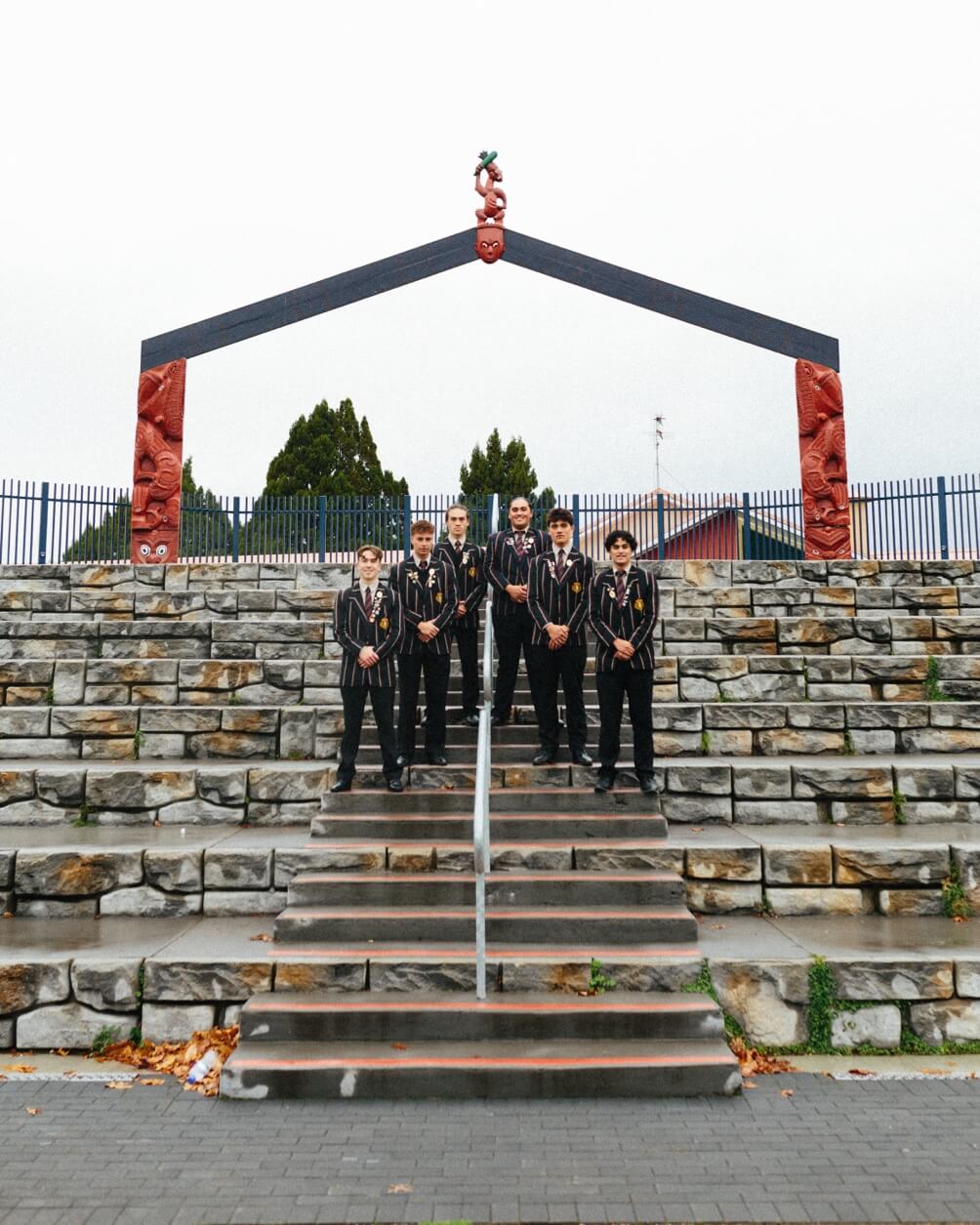
Left to right: Head boy Rohm Dixon, Deputy head prefect Koan Hemana, Te Akitu house captain Mathieu Boynton-Rata, Rotorua house captain Paretoroa Webster-Tarei, Pasifika captain Meleki Schuster and Academic captain Blue Simpkins-Jones.
At the top of the school logo sits the Tāne Raukura, painted in traditional red, symbolising the relationship with Ngāti Whakaue. In 1880, the iwi, who are the mana whenua of much of Rotorua, gifted the land that the school rests on for educational purposes. The Tāne Raukura memorialises that gift, sitting above the Crown and the Lion which, in the words of school historian Kevin Lyall, represents “the relationship of the school to the Sovereign and to the Crown” and the “relationship of the school to British traditions”. This connection to the Crown and to British traditions is hardly uncommon in boys boarding schools like Rotorua Boys’ High School. The British did invent, and then establish across the colonies, this model of education.
But in 2022, with the largest Māori roll in the country, and with a rich connection to the generosity of Ngāti Whakaue, that connection to queen and country seems outdated. And so, under Grinter’s principalship, the school is on a journey to, in his words, “decolonise”.
That journey is part of the school’s pedagogy. For some years the school participated in the professional development programme Te Kotahitanga, and all staff now take part in a school-based programme informed by Te Kotahitanga principles. In Grinter’s words, the devel- opment programme “unpacks the traditions of the school, unpacks the pedagogy of the majority”. Teachers no longer dictate from the front. As part of the programme, they engage with stories from Māori learners, helping shift their perspective around what Māori students might need, before receiving intensive classroom support and feedback. According to figures from the mid-2000s, Te Kotahitanga schools significantly outperform non-Te Kotahitanga schools in achievement at NCEA Level 1. That includes achievement across different ethnic groups, not just Māori.
Grinter credits his staff, mana whenua and the wider school community with helping enact the changes that make the school “culturally responsive”. “Our iwi has been fantastic,” Grinter explains, “[driving] some of the major steps in this journey.” For example, the school houses were formerly Nelson, Frobisher, Raleigh and Drake — names taken from great British admirals and military heroes, nods to the school’s British tradition. But, as Grinter explains, “it didn’t fit the context of our boys… now we’ve used our school pepeha to name our houses. It gives us a pinpoint accuracy that is totally relevant to the young men of our school and makes us unique.” The new houses are Te Akitu a Raukura, Ngongotahā, Utuhina and Te Rotorua-nui-a-Kahumatamomoe.
The changes to the house names reflect design changes across the school. Raukura plumes welcome visitors to the school, framing the entrance like a waharoa. The proud raukura man sits in the entryway to the reception as well. When parents call the school the automatic answer machine is the head boy offering a greeting in Māori. The hold music is a recording of the Raukura kapa haka group. Various taonga adorn the school, reinforcing to Māori boys that the school is very much their place. The cultural integration across the school seems natural, even though, for a state school, it is extraordinary.
In 2010, King’s College, perhaps the most prestigious boys’ school in New Zealand, made te reo Māori compulsory for all Year 9 students. In 2016 Auckland Grammar followed suit, and in 2018 Macleans College opted for making a broader course, Māori Studies, compulsory for Year 9 students. Wealthy schools tend to exploit their advantage as first-movers, using their resources to attract increasingly-in-demand te reo Māori teachers. But Rotorua Boys’ High was ahead of this pack, making its own te reo Māori course compulsory for Year 9s in the mid-2000s at a time when, politically, it was potentially unpopular to do so. In 2004, the then National Party leader Don Brash delivered his Ōrewa speech, condemning so-called Māori privilege and leading to a rush in government to remove explicit references to ‘Māori’ programmes, policies and funding mechanisms.
Te Reo Māori is also available at all levels at Rotorua Boys’ High. But is this part of a journey to “decolonise” the school, as Grinter says? For Morris, it is less about decolonisation as it is about building a school that reflects the boys who make it. “Decolonising, within the context of Raukura as a school, is not really a term we use. I certainly don’t, even as an individual, because I suppose what we focus more on is becoming more and more culturally responsive.” That means building an environment where the boys feel “connected with, safe, protected, [and] valued”. This starts with the teaching staff, a quarter of whom are old boys and thus understand the wairua and kaupapa of the school in a personal as well as professional way.
This is a significant structural change, prioritising the search for Māori teachers. “I have searched the land, if I can exaggerate a little bit, to find good Māori role models for our school,” says Grinter. “And, in that regard I think that, as a school, we’re blessed. We would have arguably the strongest Māori faculty of any school in the country with six fluent, full-time Māori teachers — all of whom are, in their own fields, stars.”
Taken together, the reforms at Rotorua Boys’ High — the design changes on the school campus, the professional development programme, the increase in Māori staff, the availability of te reo Māori and the house name changes — are significant. And they work. Education Review Office reports are often written in a dry, detached style, but in its report on Rotorua Boys’ High the Ministry of Education-appointed reviewers are unusually enthusiastic, noting the school’s “100-year history of students aspiring to national and international success”. The reviewers also note that “overall student achievement in NCEA is well above the national comparisons and averages for similar schools”, pointing out the impressive achievement levels for Māori students. “Māori and non-Māori student achievement is comparable”. In 2014 the school achieved the Ministry of Education’s goal of 85% achieving at or above in NCEA Level 2 as well.
This is an endorsement of the “culturally responsive” changes that have taken place. But those changes were, as Grinter notes, not necessarily as enthusiastically welcomed across the community. “There has been some degree of white flight, if I can call it that… Some of the non-Māori community are less confident in what the evolution of the school might mean for them as non-Māori. I’m conscious that next door is a Catholic integrated school with a very small percentage of Māori students. And so that is, in a way, the community speaking — or the Pākehā community speaking. To me that’s a little sad because our city is strongly bicultural and the schools used to reflect that. Now we’re a little bit more focused — but, having said that, our school role has grown every year. We’ve moved over the last 20 years from being the smallest high school in the city to the largest, so I guess that speaks volumes, too.”
In 2006 “white flight”, an American term that describes the phenomenon of white families moving out of areas with growing minority populations, was blamed for the closure of Sunset Junior High School, a former intermediate school in the suburb adjacent to Rotorua Boys’ High School. Sunset went from a school roll of over 700 in the early 1980s to a roll of 70 in the mid-2000s. But that roll decrease, and the corresponding increase in the proportion of Māori students, likely reflected shifting demographics as much as it reflected conscious parental choices. In 2017, Māori made up 35% of Rotorua’s population as a whole but over 51% of its high-school-aged population. These roll changes reflect demographic shifts happening across the country. The Māori population’s age profile is younger than the non-Māori population’s, meaning that, in many ways, Rotorua Boys’ High reflects the future of education in New Zealand.
One of the distinguishing features of Rotorua Boys’ High is that the school maintains its own Instagram page. The school is also well known, at least among Generation Z, for producing an unusually large number of Tiktok-famous students. In that sense, the school and the manner in which it engages with its students is quite modern. But there are aspects of the school where tikanga still rules. At the entrance to the whare — the home of tikanga, mātauranga and reo Māori on campus — sits a sign that reads “no devices”. According to Morris, “there are some elements of te ao Māori that should not be touched by technology”. For Jamus Webster (Te Arawa, Te Whānau a Apanui, Tūhoe, Ngāpuhi), the director of the school’s Māori Performing Arts Academy, “a lot of students gravitate to their phones because they’re trying to block out what’s happening around them.”
But learning and pedagogy at the whare attempt to ground the students in place. Young men are often accused of being “poor communicators”, Webster explains, but a grounding in te ao haka — the world of haka — helps Māori boys develop “soft skills” like public speaking and expression. Those skills can be learned by young men of different ethnicities too. “We’re a highly culturally responsive school,” said Webster. “We’re coming from a multicultural society. Sometimes we just look at [cultural responsiveness] as two-fold — Māori and Pākehā. But actually we have to be encompassing and manaaki everyone, [including] others that are in here. It’s about understanding — understanding each other and respecting who they are, where they belong, their language, their spiritual beliefs and nurturing it together as a whole.”
Principal Grinter cites this connection to te ao haka as one of the turning points for staff and students on their decolonisation and cultural responsiveness journey. All staff learn a waiata-ā-ringa, an action song, and Grinter sheepishly admits he is usually at the back of the group. In 2020 a call went out for staff to perform and record the waiata ringa, with participation voluntary. But, as Morris and Webster explain, the entire staff turned out, turning to one another and hugging after it was done. “We can’t expect for others to do something if we’re not doing it ourselves,” says Morris. This sentiment recurs across the staff at the school — that they must walk the decolonising and cultural responsiveness talk inside and outside of school. “I’ll no sooner pick up the tea towel and do dishes as well as be in the wharenui if I’m called on. The students then see the staff embodying what they are asking them to do and be.”
In interviews with staff, the term ‘ākonga’ comes up again and again. This roughly translates to learner and is less common than ‘tauira’ which roughly translates to student. That terminology in itself is important — Te Kotahitanga encourages teachers to see their “learners” more holistically, and that change in perspective influences every aspect of school life. When the ākonga saw the video of the staff performing the waiata ringa, Morris and Webster explain, they were “stoked” and “really engaged with the staff about their performance”. Staff and ākonga enjoy a closer relationship than the traditional British model allows, where the teacher, in Grinter’s words, “dictates” from the front and the students gratefully receive their instruction.
Old boys of Raukura often say “three feathers to the sky, Boys’ High till I die”. For some New Zealanders, high school is something best forgotten. But for old boys of Rotorua Boys’ High their experience forms part of their identity. Perhaps that is because at Rotorua Boys’ High “every day is a happy day”. More likely, though, this is because at Rotorua Boys’ High, the staff, the curriculum and the pedagogy are built to reflect, reinforce and grow that identity. And this is the aim of the school’s decolonisation journey.
–
This column was published in Metro 435.
Available here.


